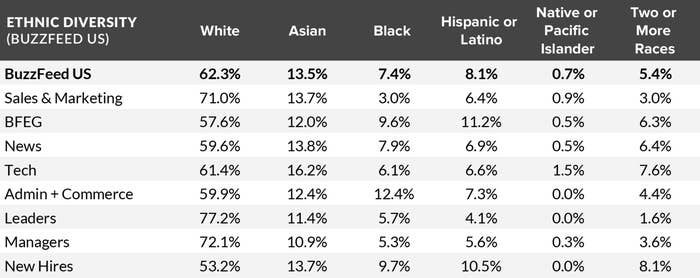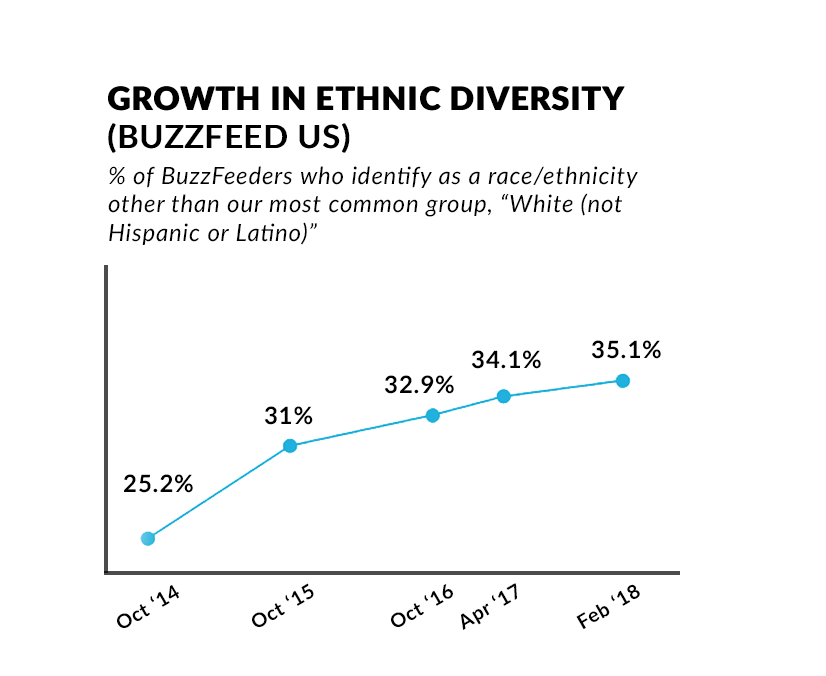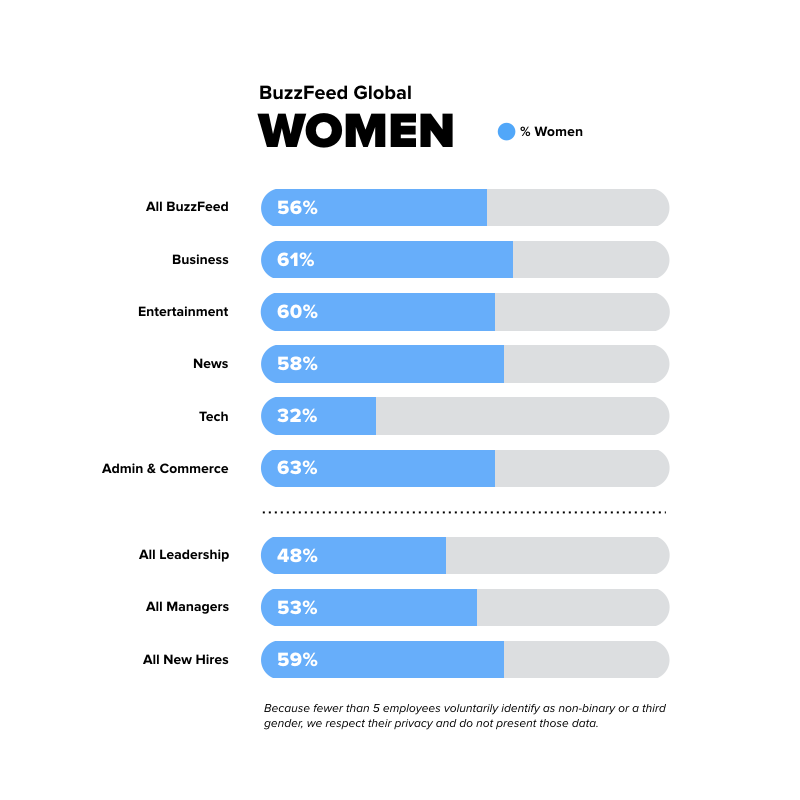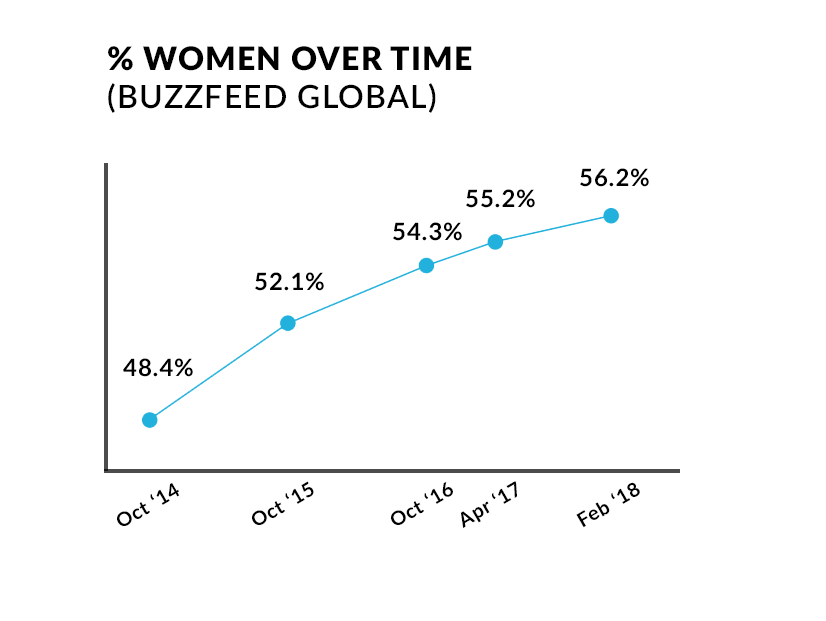Every year, I write to share our progress on being a more diverse and inclusive company, and affirm our commitment to creating a workplace that welcomes and elevates all BuzzFeeders. You can read my most recent memos here and here.
Diversity, inclusion and belonging are critical to BuzzFeed in any year, but 2017 somehow magnified the importance of these values to who we are and what we put into the world. This was a year that saw a sweeping feminist movement challenge traditional power structures across industries and throughout government; it saw a rise in xenophobia disrupt the lives of immigrants, migrants and refugees in countries around the world; it gave America a frightening resurgence in white nationalism that manifest itself in incidents like Charlottesville. These examples show why it is so important for companies to stand strong on values of diversity and inclusion – both to participate in positive social change and to fight against efforts by hate groups to disrupt them.
At BuzzFeed, we touch these issues and explore the experiences of diverse people every single day. We use our platforms to elevate diverse creators who give voice to underrepresented people. We conduct original reporting that holds the powerful to account and provides a check to bigotry and hatred. We would not be able to do any of this if we did not have a diverse workforce and inclusive workplace, where everyone — regardless of gender, race, or sexual orientation — is seen and heard.
Thanks to all you to do for helping create that environment here at BuzzFeed. Below are our numbers, which we share to track our progress and hold ourselves accountable to each other and the public.
OUR WORKFORCE
Race/Ethnicity (U.S.)
More than 35% of U.S. employees identify with a race/ethnicity other than our most common group, White (not Hispanic or Latino/Latina), up slightly from 2016. Employees who identify as one of these less-represented groups make up:
42% of active new hires employees hired in the last 6 months (U.S.)
23% of our U.S. leadership (director level and above), up from 15% last year
38% of our reporting and content groups, News and Entertainment (U.S.), flat to last year
39% of our Tech organization (U.S.) up from 36% last year


*This reporting adheres to the Equal Employment Opportunity Commission’s designated identity selections for compliance and standardization. The full identification given for each item are White (Not Hispanic or Latino), Asian (Not Hispanic or Latino), Black or African American (Not Hispanic or Latino), Hispanic or Latino, American Indian or Alaska Native or Native Hawaiian or Other Pacific Islander (Not Hispanic or Latino), and Two or More Races (Not Hispanic or Latino)
Gender (Global)
BuzzFeed is made up of more people who identify as women (56.2%) than ever before. Globally, women make up:
- 48% of global leaders, up from 46% last year
- 53% of global managers, flat to last year
- 32% of our Tech organization, up from 30% last year


Sexuality and Gender Identity
While we do not yet report on our data on sexuality and gender identity, we allow our employees to voluntarily self-identify in a way that reflects their true selves.
Age
BuzzFeed’s extremely successful early career programs — including our Video Fellowship program — drives a workforce with a significant number of employees under 30. In fact, nearly 20% of our employees began with the company in an internship or fellowship. Still, more than half of our employees are over 30 and every age group — from 18-24 to 60-64 — is represented here.
Additional Self-Identification Categories
We continue to monitor trends within our organization — as well as greater trends in culture — to ensure we provide employees the ability to self-identify in all the ways that are important to them. While we do not currently track additional self-identification categories including Veteran Status and Ability, we will consider doing so in future reports.
OUR PRACTICES
BuzzFeed implemented and solidified many practices in 2017 to ensure that not only are we a diverse workforce, but that all of our employees experience equality, inclusion, and belonging.
Diversity
Diversity is measured and the resulting data served to BuzzFeed leadership on an ongoing basis throughout the year. We consider all parts of the employee life cycle. In recruitment, we ensure that we are targeting a diverse cross-section of candidates, and that we are hiring the best people in the labor market. In terms of our current employees, we use team-level measures to maximize the diversity of perspectives throughout the organization.
Equality
Equality is central to all of our compensation and promotion processes. Our leaders, managers and People Team are driven by data to determine that merit and advancement are without bias across genders and ethnicities.
Inclusion & Belonging
We measure inclusion and belonging by measuring key behaviors including retention and surveying our employees. Through employee feedback, we have good indication that BuzzFeeders of all ethnicities and gender identities feel they can be their true selves: last year, 88% of all BuzzFeed agreed with this sentiment, and in the past year of new-hire surveys, that number has climbed to 93%.
Employee Resource Groups
In 2017, we significantly expanded our Employee Resource Groups (ERGs). The majority of our ERGs launched last year and have grown to reach more than half of BuzzFeeders in the U.S.
We currently have ERGs focused on the following affinities: women (NYWomen@, Women of the West), Asian/Pacific-American identity (A*POP), Black identity (B.I.O.), Latinx identity (Mi Gente), and LGBTQ+ (OUT). These groups are led by employee volunteers, with the support of BuzzFeed leadership and the People Team. In 2017 alone, BuzzFeed ERGs have contributed to the company in myriad ways, including employee mentorship; monthly leadership lunches and events; connecting employees across teams and offices; referring more than 50 candidates for open roles; fundraising for disaster relief; and hosting celebrations and events for Lunar New Year, Día de los Muertos, Black History Month, Women’s History Month, Pride and Diwali, and more.
Reporting Methodology
Methodology: based on all regular employees who self-reported gender and race/ethnicity data. Data reflects best-available information on 2/1/18. New hires reflect those with start dates within 6 months of 2/1/18. Due to rounding, undeclared employees, or unavailable data, values may not always sum to 100%.
This reporting adheres to the Equal Employment Opportunity Commission’s designated identity selections for compliance and standardization. Internally, however, we know employees may prefer to identify by other language.
